
The Hellenic Army, formed in 1828, is the land force of Greece. The term Hellenic is the endogenous synonym for Greek. The Hellenic Army is the largest of the three branches of the Hellenic Armed Forces, also constituted by the Hellenic Air Force (HAF) and the Hellenic Navy (HN). The army is commanded by the chief of the Hellenic Army General Staff (HAGS), which in turn is under the command of Hellenic National Defence General Staff (HNDGS).

The Beretta Model 1934 is an Italian compact, semi-automatic pistol which was issued as the service pistol of the Royal Italian Army beginning in 1934. As the standard sidearm of the Italian army it was issued to officers, NCOs and machine gun crews. It is chambered for the 9mm Corto, more commonly known as the .380 ACP.

The Brodie helmet is a steel combat helmet designed and patented in London in 1915 by Latvian inventor John Leopold Brodie. A modified form of it became the Helmet, Steel, Mark I in Britain and the M1917 Helmet in the US. Colloquially, it was called the shrapnel helmet, battle bowler, Tommy helmet, tin hat, and in the United States the doughboy helmet. It was also known as the dishpan hat, tin pan hat, washbasin and Kelly helmet. The German Army called it the Salatschüssel. The term Brodie is often misused. It is correctly applied only to the original 1915 Brodie's Steel Helmet, War Office Pattern.

The Stahlhelm is a term used to refer to a series of German steel combat helmet designs intended to protect the wearer from common battlefield hazards such as shrapnel.

The M1 helmet is a combat helmet that was used by the U.S. military from World War II until 1985, when it was succeeded by the PASGT helmet. The M1 helmet has become an icon of the US military, with its design inspiring other militaries around the world.

The Metaxas Line was a chain of fortifications constructed along the line of the Greco-Bulgarian border, designed to protect Greece in case of a Bulgarian invasion after the rearmament of Bulgaria. It was named after Ioannis Metaxas, then Prime Minister of Greece, and chiefly consists of tunnels that led to observatories, emplacements and machine gun nests. The constructions are so sturdy that they survive to this day, some of which are still in active service. Some of them are open to the public.

The Balkans theatre or Balkan campaign was a theatre of World War I fought between the Central Powers and the Allies.
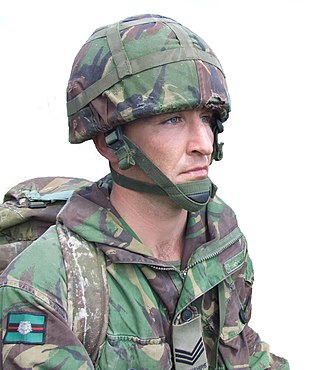
A combat helmet or battle helmet is a type of helmet designed to serve as a piece of personal armor intended to protect the wearer's head during combat. Modern combat helmets are mainly designed to protect from shrapnel and fragments, offer some protection against small arms, and offer a mounting point for devices such as night-vision goggles and communications equipment.

The War Museum of Thessaloniki is a military museum in Thessaloniki, Central Macedonia, Greece.

The modern Greek Army has a history of almost 200 years, during which it has undergone dramatic changes and been involved in some of the major conflicts on the European continent. The modern Greek military throughout its history was closely following international developments in equipment and uniforms. With the notable exception of the elite Evzones units, which based their uniforms on the indigenous traditional garments of the 18th century, the rest of the Army, as most militaries worldwide, was always quick to adopt the military fashion current among the armies of the influential Great Powers. This influence can be roughly divided in three periods: French-style uniforms, which dominated throughout the 19th century, the British styles introduced around World War I and used during World War II and until the late 1960s, and the "NATO" or US-style predominating from ca. 1968 onward. Various individual items or details can of course be traced to other influences, and there were also transitional uniforms combining previous designs.
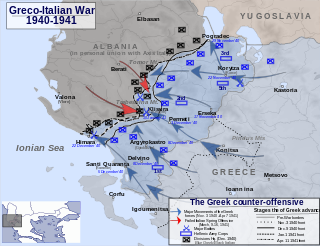
The Italian spring offensive, also known as Operazione Primavera, was an offensive of the Greco-Italian War that lasted from 9 to 16 March 1941. The offensive was the last Italian attempt of the war to defeat the Greek forces, which had already advanced deep into Italian-controlled Albania. The opening of the offensive was supervised by the Italian dictator Benito Mussolini but ended a week later in complete failure.

The SSh-60 (СШ-60 was a product improvement of the Soviet SSh-40 steel helmet of the Soviet Army and entered production around 1960. It was not fundamentally different from the previous World War 2 era SSh-40, the primary difference being an updated liner/suspension system.
The M76 Paratrooper helmet is a combat helmet of British origin issued to paratroopers and airborne forces of the British Army.
The M33 Helmet is a steel combat helmet designed in the 1930s in Italy, and was the standard combat helmet of the Regio Esercito up to World War II, and of the Esercito Italiano well into the Cold War.
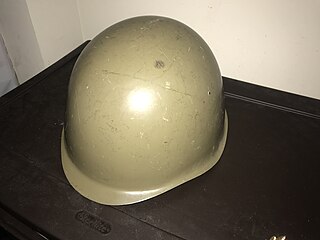
The Czechoslovak M53 helmet was used by the Czechoslovak Army from the early 1950s onward. In western European countries and the United States, it is sometimes referred to as the Czech M53 helmet. These helmets are commonly mistaken for, and sometimes marketed as, Soviet SSh-40 helmets, and various other very similar Eastern Bloc helmets.

The M1934 helmet is a steel combat helmet used by various factions in the Spanish Civil War. Not meant for use by the Spanish Army, but instead by security forces such as police, the helmet was of similar shape to the Model 1926 helmet in use by the army. The helmet was mainly used by the Nationalists in the conflict.
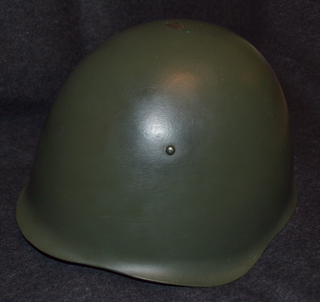
The Wz50 also known as M50 is a steel combat helmet used by Poland from its introduction in 1950 to its replacement by the Hełm wz. 67 in 1967. The helmet would be widely exported to a number of Arab countries for its low price. Early pre-production helmets by a double riveted chinstrap and cow skin leather liner. All models of helmet would include an maker and manufacture stamp

The M34 is a steel combat helmet used by the Netherlands from its introduction in 1934 replacing the previous M23/27, to the invasion by Nazi Germany in 1940. From which it was replaced by the M53 helmet, a local copy of the American M1 helmet. A tropical variant of this helmet was produced for use by the Dutch East India Army in present-day Indonesia known as the KNIL model.
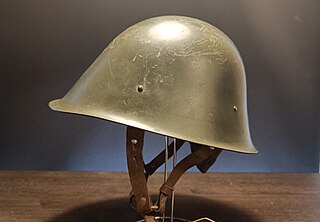
The Model 1973 is a Romanian steel helmet used by the army of Romania, introduced in 1973 in the Army of the Socialist Republic of Romania.























